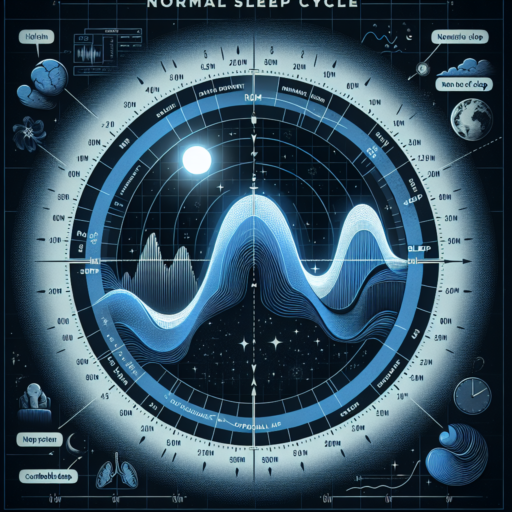What should a normal sleep cycle be?
Understanding the dynamics of a normal sleep cycle is essential for establishing both a healthy routine and optimizing overall well-being. The human sleep cycle plays a pivotal role in cognitive functions, emotional balance, and physical health. A typical sleep cycle follows a pattern known as the circadian rhythm, closely tied to the natural sequence of daylight and darkness.
Components of a Normal Sleep Cycle
Within a 24-hour period, a standard sleep cycle is comprised of several stages, including four stages of Non-Rapid Eye Movement (NREM) sleep and one stage of Rapid Eye Movement (REM) sleep. These stages are characterized by different brain activity levels and are essential for various restorative functions:
- Stage 1 NREM: The transition from wakefulness to sleep, lasting several minutes.
- Stage 2 NREM: Light sleep preceding deeper sleep stages, where heart rate and body temperature begin to drop.
- Stage 3 NREM: Deep sleep stage important for physical restoration and immune function.
- REM sleep: Occurs roughly 90 minutes after falling asleep, vital for memory consolidation and mood regulation.
An average, a normal sleep cycle spans approximately 90 to 110 minutes, with individuals typically going through four to six cycles per night. Achieving a harmonious balance among these stages is key to waking up feeling rested and rejuvenated.
How long is a healthy sleep cycle?
Understanding the duration of a healthy sleep cycle is crucial for maintaining overall health and wellness. The human body thrives on regular, restorative sleep cycles that are integral to physical health, mental health, and daily performance. A single sleep cycle encompasses several stages, including both rapid eye movement (REM) and non-REM sleep, and typically lasts about 90 minutes. However, the total number of these cycles needed for a restful night varies among individuals.
Experts generally recommend that adults aim for about 7 to 9 hours of sleep per night, which equates to approximately four to six sleep cycles. This time frame is considered optimal for the majority of adults to ensure they are going through the necessary stages of sleep, including the deepest and most restorative phases. It’s during these cycles that the body undergoes repair, memory consolidation, and a reset of the system, crucial for emotional and physical well-being.
It’s also worth noting that the quality of these sleep cycles matters just as much as the quantity. Factors that can influence the quality of sleep include sticking to a consistent sleep schedule, ensuring a comfortable sleep environment, and limiting exposure to light and screens before bedtime. By focusing on both the duration and quality of sleep, individuals can maximize the health benefits of their sleep cycles, ultimately contributing to a healthier lifestyle.
No se han encontrado productos.
How much REM sleep is normal?
Understanding the normal range for REM sleep is crucial for assessing overall sleep health. REM, or Rapid Eye Movement sleep, is a stage of sleep characterized by quick, random movements of the eyes, low muscle tone throughout the body, and the propensity to dream vividly. It is considered a vital aspect of sleep, facilitating memory, learning, and emotional regulation.
For most adults, REM sleep constitutes about 20% to 25% of total sleep time. This translates to roughly 90 to 120 minutes of REM sleep per night for someone who sleeps 8 hours. However, it’s important to note that this percentage can vary from person to person, depending on several factors including age, sleep patterns, and overall health. Infants, for example, spend about 50% of their sleep time in REM, reflecting the critical role of this sleep stage in brain development.
While the quantity of REM sleep is a helpful indicator of sleep quality, the distribution of REM cycles throughout the night also matters. REM sleep periods tend to lengthen progressively with each sleep cycle, with the longest periods occurring in the final thirds of the night. Therefore, ensuring uninterrupted sleep, possibly by maintaining a consistent sleep schedule and a bedtime routine, is essential for achieving normal REM sleep quantities and distribution.
Which is better, REM or deep sleep?
Understanding the roles of REM and deep sleep is crucial in appreciating how they contribute distinctly to our overall health and well-being. Both stages are essential components of a good night’s sleep, playing unique and complementary roles in our sleep cycle.
The significance of REM sleep
REM sleep, or Rapid Eye Movement sleep, is most commonly associated with dreaming. This stage is vital for emotional regulation, memory consolidation, and brain development. During REM sleep, your brain is almost as active as it is when you are awake. This active state supports various aspects of cognitive function, including the processing and storage of information gathered throughout the day.
The importance of deep sleep
Deep sleep, on the other hand, is the most restorative phase of sleep. It’s during this stage that your body repairs tissues, strengthens the immune system, and builds bone and muscle. This period of deep sleep helps to rejuvenate both the body and mind, preparing you for the activities of the following day. Because of its healing qualities, deep sleep is essential for physical recovery and growth.
Each phase of sleep serves a specific purpose. REM sleep is crucial for cognitive and emotional health, while deep sleep is foundational for physical recovery and growth. Understanding the importance of both can help individuals prioritize their sleep health to benefit fully from each stage.




